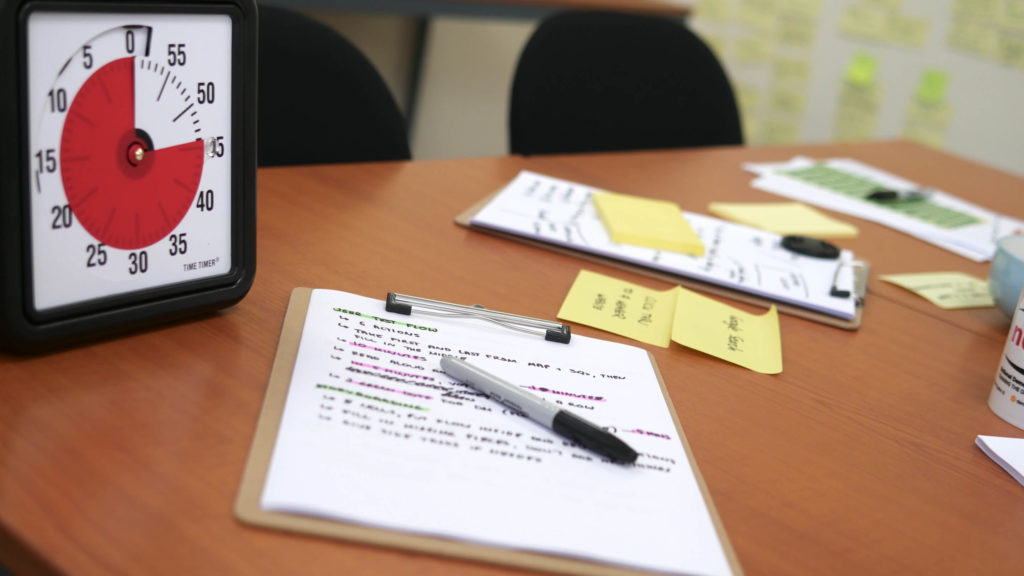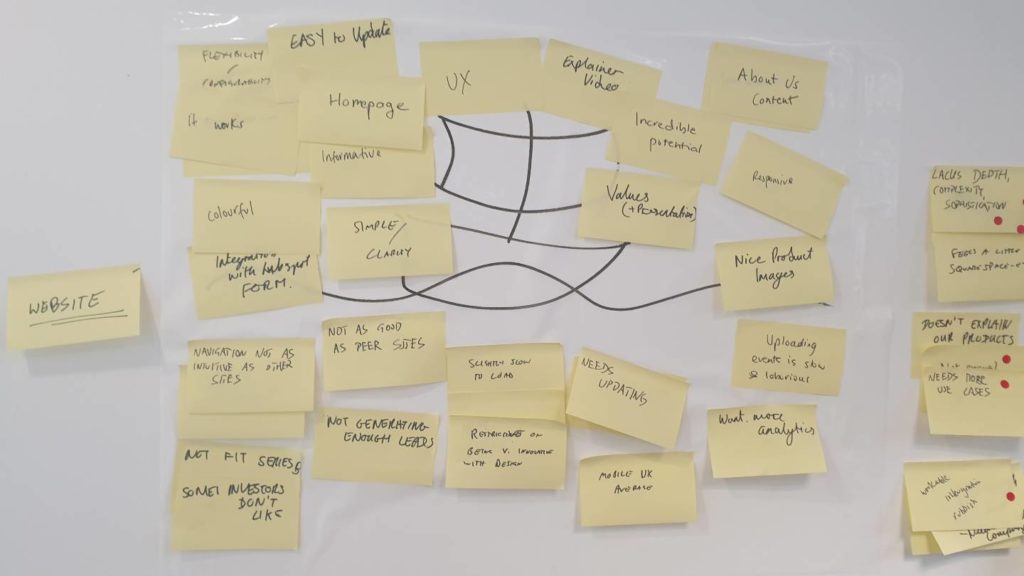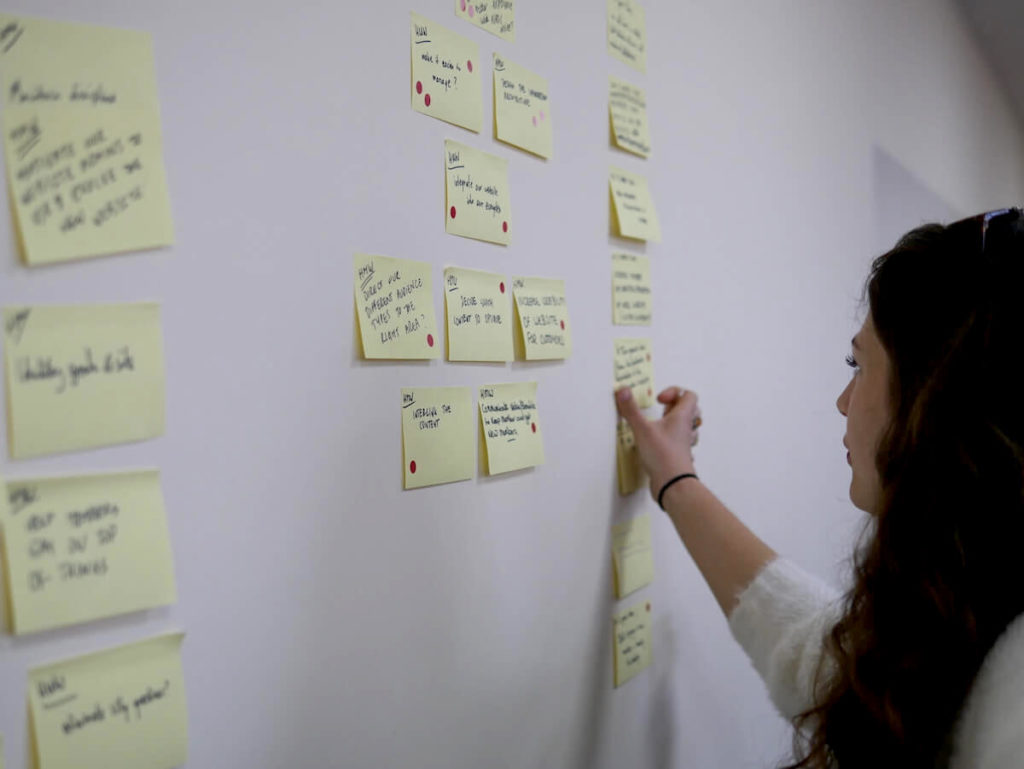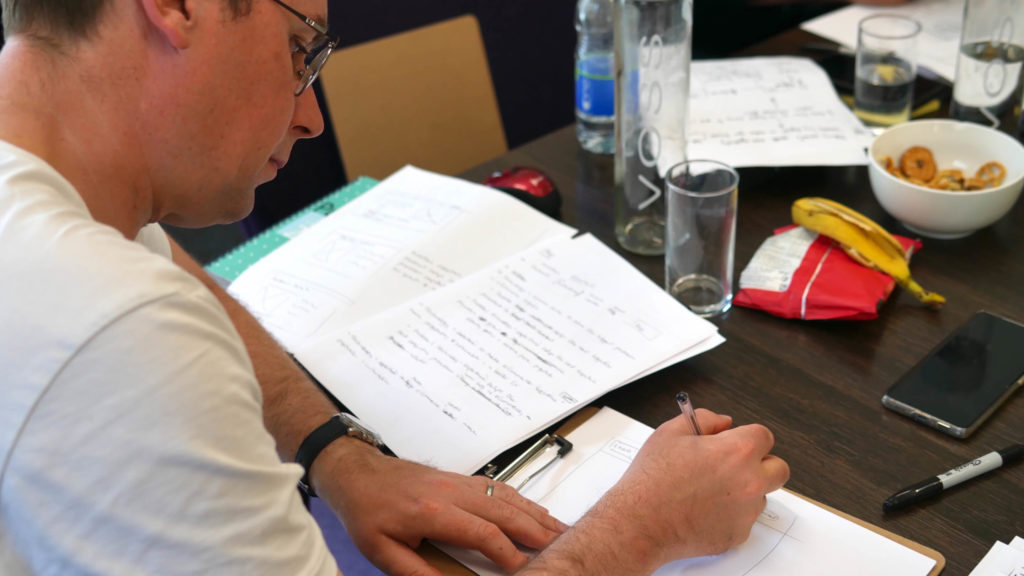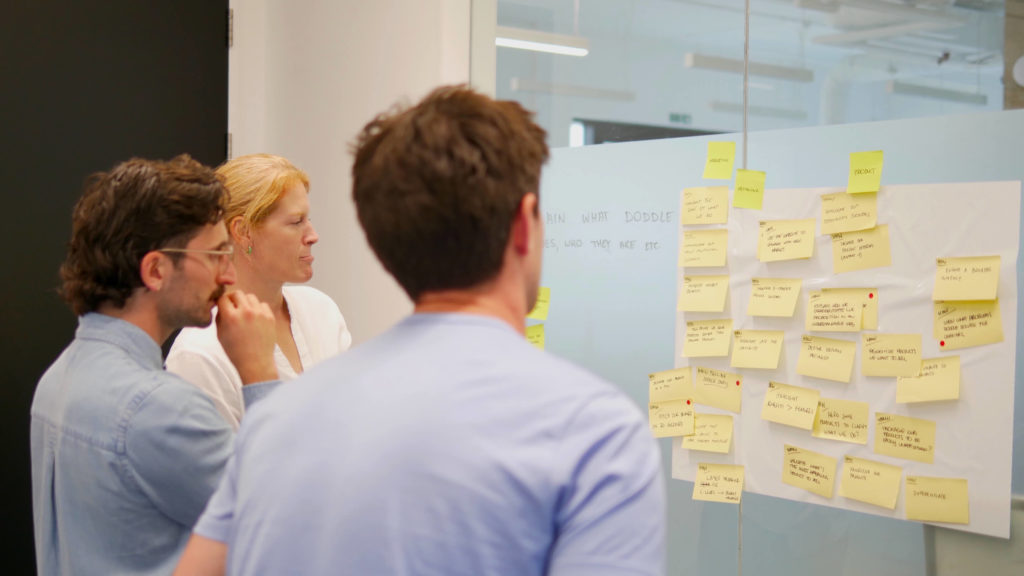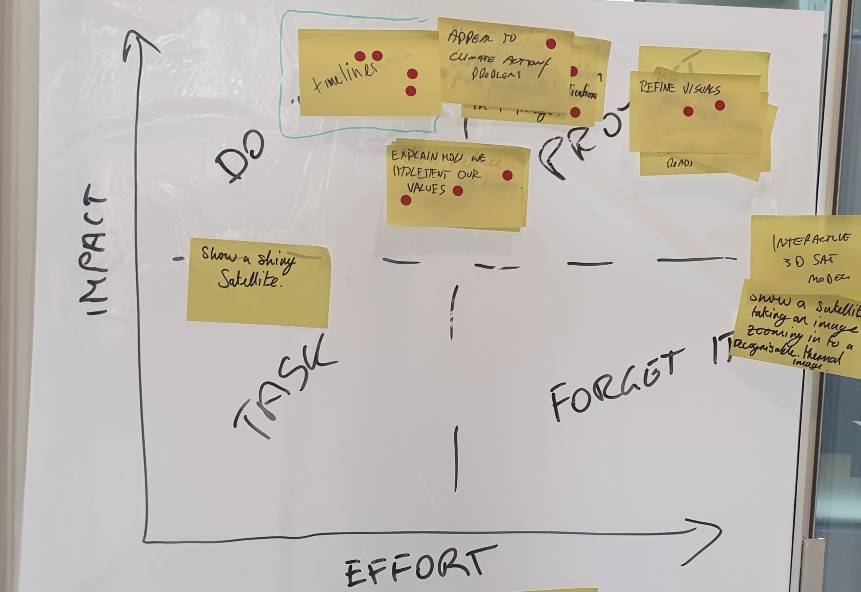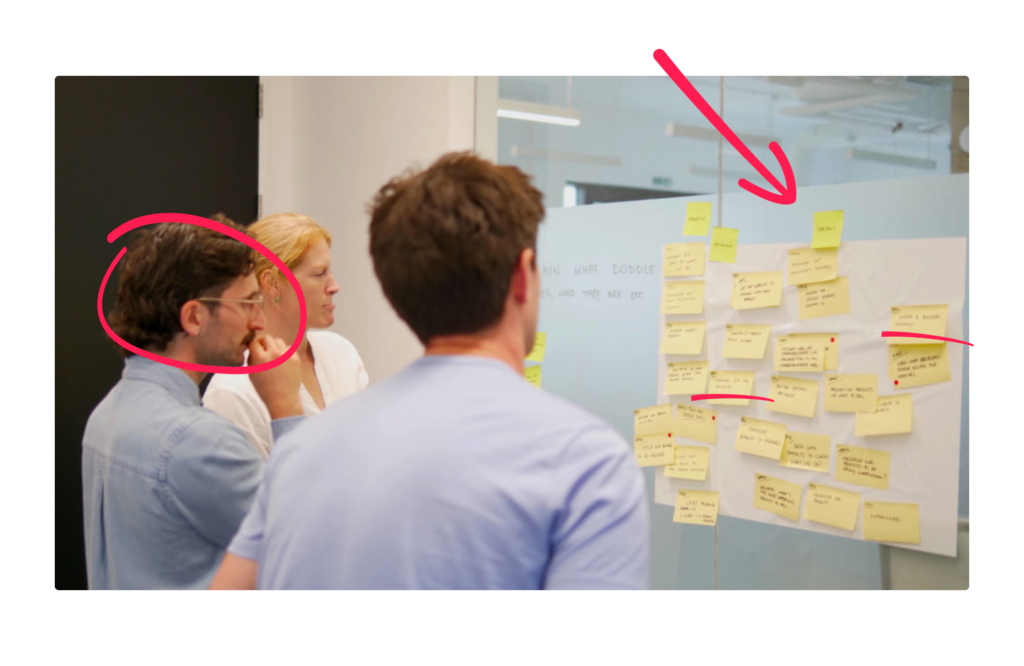Solve problems in one hour with Lightning Decision Jam
Solving problems in a meeting is a bit of a myth. They drag on; the group gets overpowered by the loudest voices, and it usually ends with an email and an invitation to a follow-up meeting. What if I told you there’s an infinitely better way to do that? It takes just an hour, you can do it remotely and applies to any kind of problem. Written by Tomasz LisieckiOur hourly workshop is inspired by the Lightning Decision Jam (LDJ), a process coined by AJ&Smart, a German innovation & product design agency. It works like a charm for any broad challenge. It involves a lot of problem statements, ideation and voting – but almost no talking at all!
What type of challenges can a Lightning Decision Jam solve?
We’ve used it to help clients identify the biggest issues with their organisation, but also to pick the destination for our Christmas party in 2021!
The process works best for broad & more complex challenges, but you can use it for virtually anything. If your problem is specific (i.e. our Christmas party), the workshop will need slight adjustments to not feel like we’re running in circles – more on that later.
Some of the challenges we helped solve include:
- a lack of alignment in a team
- making the website a higher priority in the day-to-day operations
- improving the perception of the business in the eyes of the online audience
- reducing office noise to improve productivity
As you can see, it can be anything. But while some of the challenges seem attainable within an hour, how do you help a team sing from the same page in just an hour?
Before I explain how to get there, here’s what you get out of the workshop.
How to make LDJ work – the 5 key rules
What sets a Lightning Decision Jam apart from a traditional meeting is that… it’s not a meeting! It’s a fun and stimulating workshop, but the outcome relies on a set of rules the team has to follow.
These can be a bit abstract at times. We’ve been conditioned to work in a different way in the past, but once you give it a shot you won’t ever go back.
Rule 1Getting started is more important than being right
I don’t know about you, but I love being right. This makes following the first rule a bit hard for me, but in the end, innovation is all about challenging ourselves and going out of our comfort zone.
In some of the exercises, we ask you for quantity over quality. You have to start writing, keep writing and only stop once the time is up. It’s a team effort, so we’ll weed out the low-quality ideas and responses.
It’s a stark contrast to the everyday operations of businesses that demand perfection from us – but it works!
Rule 2Tangible results are more valuable than discussion
Your idea is valid regardless of what others think about it. Again, the workshop is structured in a way that will lead us to the qualitative outcomes – without the need for discussion. If you think someone’s idea is silly, you’ll be able to voice it without saying a word.
Don’t second-guess your ideas with the mindset of “what will others think about this?”
Rule 3Don’t rely on creativity
That’s a fun one! We have a longer workshop based on the Design Sprint process which involves a bit of drawing and sketching, on top of the ideation. This terrifies some people because “they’re not creative”.
You don’t have to be. Your tangible experiences are just as valuable, if not more. Simple ideas are often the best. They’re easy to implement and validate, and they usually just work. If you think a solution to a problem is “close the company”, write it down!
Rule 4We work together, but alone
If you’re into memes, you’ll know this image of a schoolboy trying not to speak in class:

This is exactly what you need to do… but maybe without the physical and mental strain!
I like comparing workshops to the concept of active listening. The idea says that when someone speaks, you shouldn’t speak yourself and you shouldn’t even think about speaking. Just soak in the information and give it your full attention.
In workshops, we work alone most of the time. You’re not concerned about what others think, say, or do. If you’ve spotted someone writing down a better idea than yours, first of all, stop looking at them! And second, you don’t have to one-up them. Just follow the instructions from the facilitator.
Rule 5Trust the process and have fun
This is a final and perhaps the most important rule. Lightning Decision Jam was invented to tackle the problems of traditional, unstructured discussion. The workshop is highly structured and the exercises complement one another.
And it’s a lot of fun! You’re challenging yourself without unhealthy competition and in the end, you’re still more productive than in a meeting.
As a bonus, in-person workshops usually involve snacks. Heck yeah!
The outcome of a Lightning Decision Jam is an actionable experiment (2 examples)
A traditional meeting often ends with an email to all attendees where one person summarises what everyone said, and invites them to another round of flawed discussion.
In this case, you get a 2-week action plan to test the decisions made in the LDJ. This makes a world of difference, doesn’t it?
Here’s how you build the experiments, based on two examples from workshops that we facilitated.
An experiment to add a company timeline to the About Us page

This was related to a challenge about improving the perception of the company I mentioned in the intro. You’ll learn how to get there in a second, but it’s only fair to show you the value of the workshops before taking you through the steps to get there.
We’ve created a three-step plan that included:
- the deadline
- an actionable task
- an assignee
We start with an instant, actionable task. It should be attainable within 24 hours of completing the workshop. In this case, we’ve asked Toby to share the content for the timeline with the team via email. It was doable within hours because the task relates to facts, rather than creative copywriting.
Next, a mid-term task is completed within a week of the workshop. In this case, Zena was supposed to gather inspiration and examples that would shape their timeline.
And finally, a long-term task needs to be completed within two weeks. Here it was simple – Zena was going to use the website editor to build the timeline based on the inspiration from step two.
Introducing a weekly standup meeting to a company
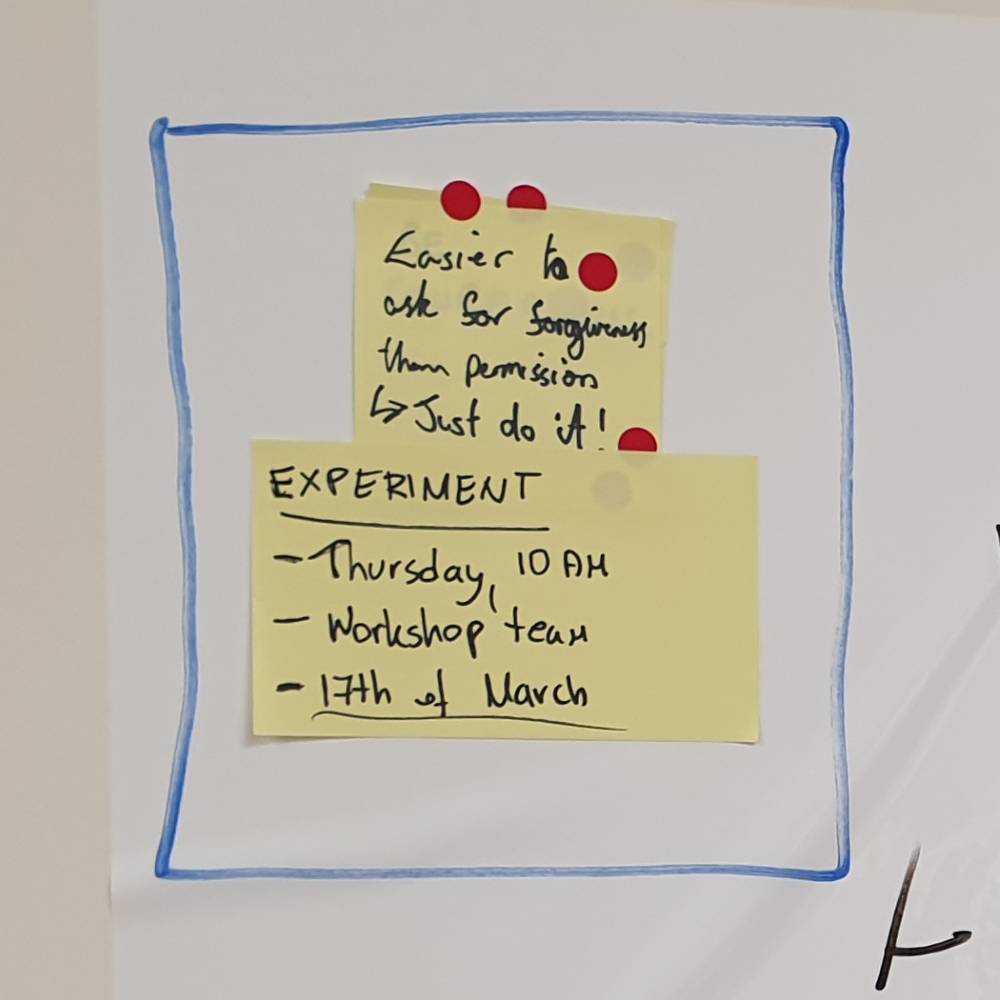
There will be times when the experiment is less complex. In this case, even though our broad challenge was a lack of alignment in the team, we’ve decided they should test a weekly standup meeting format.
We’ve created an actionable plan with an even shorter timeline. One person was responsible for sending out an invite to the workshop team for next Thursday. The goal was to make it a habit, and more frequently than once a week – but going from no standups to doing them daily would be a bit of a shock.
What you need to facilitate an LDJ
If you’re doing them remotely, you only need a digital whiteboard (Miro, Mural) and a video call with the participants.
But we absolutely love doing them in person, so here’s what we bring each time:
- rectangular sticky notes
- square sticky notes, ideally in a different colour
- sharpies
- sticky voting dots
- a timer
- “magic whiteboard” sheets that stick onto any surface – but if you have a traditional whiteboard or a flip chart, that’s perfect as well
And don’t forget snacks 😉
What’s your favourite workshop snack and why? 🥑
We’re all for improving our highly scientific selection of workshop snacks. Let me know in the comments what is your favourite. Remember, we’re not looking for sugary foods that make us sluggish!
Who should attend a Lightning Decision Jam?
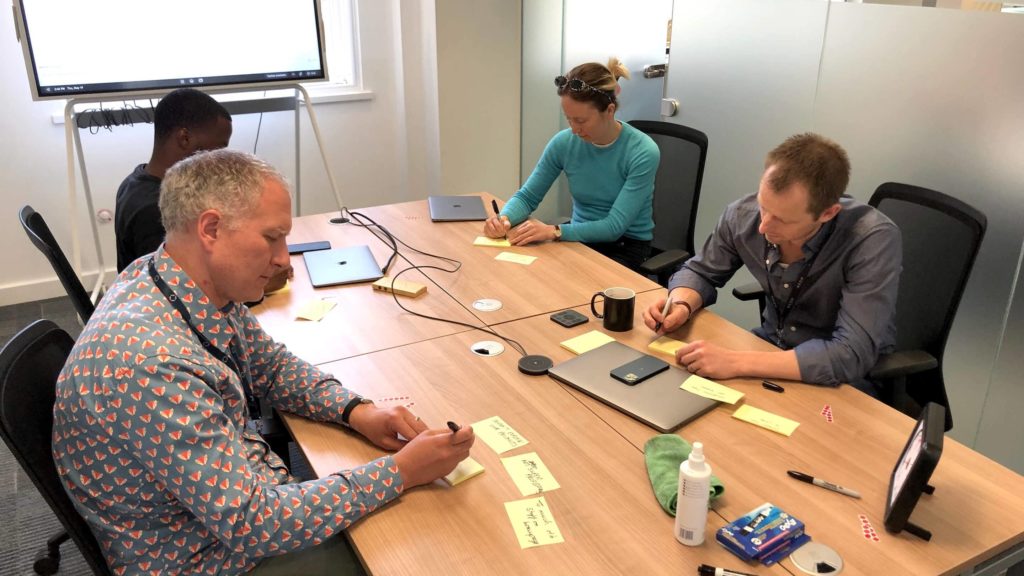
Innovation workshops benefit from having a diverse team, especially for the broad challenges. It feels intuitive to bring the entire sales team when our issue is sales – but this will usually lead to a lot of overlap between ideas. The external perspective of someone from the support or marketing teams is invaluable.
It’s also a brilliant idea to have a third-party in the workshops. Even though we mostly facilitate the workshops, we often bring someone from our team as a bonus participant. Sometimes the “curse of knowledge” can hinder our ability to see the bigger picture, and that’s where we step in – especially if it’s a website challenge.
Don’t forget about the most important first-party in your business – the customers. Recruiting someone who has actually used your product might be one of the best investments.
How many people should attend an LDJ?
We recommend Lightning Decision James with 4-8 participants.
For smaller teams, the framework works just as well – but the limited number of ideas diminishes the results.
Going over 8 is perfectly fine but it requires a major adjustment. In that case, you would split the group into multiple teams working on individual problems. Most of the time you don’t even need multiple facilitators, so this can be a great idea for a company event. It’s loads of fun, there are snacks, and you align the teams while solving problems. What’s not to like?
Lightning Decision Jam – 8 exercises, step by step
Finally, let’s go through the process step by step. There are 8 exercises in total. They’re all time-boxed and a typical LDJ takes between 30 and 90 minutes. We usually hover around the one-hour mark, but if you’re doing your 10th LDJ with the same group, it might go faster than that.
1. Frame the challenge as a solvable problem – “How Might We…”
“Home Might We” (HMW) is a framework that helps us get things done throughout the workshop. It’s not the only moment when we use it, and it will quickly become evident why. Broad challenges, i.e. “our sales are low”, are flawed. They’re usually pessimistic and uninspiring. HMWs serve as a start of a longer sentence that turns them into an opportunity, or a solvable problem. The three words already suggest the following:
- we can do something about the problem
- we might have multiple possible solutions
- we are working as a team
It might feel like a subtle change but the details and the team’s mindset are the key to success here. In the example of low sales, an HMW can be “how might we increase our sales”, or “how might we make our sales team more efficient”.
Keep in mind that the second variation narrows down the scope drastically. It assumes that the issue is the sales team, whereas it could be the product. At this stage, the broader we go, the better. Don’t worry if it all sounds too similar. Trust the process, remember?
2. The Boat – what are we doing right, and what isn’t working
The next step is drawing a sailing boat. It doesn’t have to be pretty, but it represents two things:
- the area above the water is the wind that pushes us forward – the things that we’re already doing right
- the area below is what’s dragging us down – if you’re feeling artsy, you can even draw an anchor to carry the point across
Start the exercises by giving everyone 4 minutes to note down the positives, one per sticky note. Once the time is up, everyone goes up to the boat, reads their notes and sticks them above sea level. Don’t bother with sorting duplicates or the placement of your notes – this is all about starting on a positive note.
Next, repeat that by taking 4 minutes to write down the problems. Again, one per sticky notes. Aim to write as many notes as possible. In this case, just stick them on there without reading out loud. Don’t worry about duplicates either.
3. Prioritise the problems
Now we kick things up a notch. Remember the voting dots we’ve asked you to prepare? We usually go for red circles, but you can go with anything – as long as it’s practical.
This time, the team takes 3 minutes to read the problems in silence, and vote on the ones they think are the most important to solve.
Everyone gets three dots, and they can distribute them however they want. You can vote on your own problems, and you can place multiple dots on the same note. Once that’s out of the way, take all the notes with more than one vote and sort them in a tree – with the top-voted problems at the top. If some notes are tied, put them on the same level without worrying about the order.
4. Reframe the top problem as an HMW
If two problems have the same number of dots, there is a scientific method to choose our priority. Simply pick the first one from the left 😉 Remember, getting started is more important than being right. There’s no place to discuss which of the two is slightly more important. If you wish so, you can go back to the other problem and solve it in another workshop.
Now that we have our winner, take a couple of minutes to repeat the HMW exercises from the start. If your main challenge was “HMW increase sales”, someone could’ve written down that “our servers go down once a week” as a problem. Reframe that into something along the lines of “HMW ensure our infrastructure has a 99% uptime”.
5. Note down potential solutions
This is where we go crazy. We stick to the “one idea per sticky note” rule and write down any potential solution. The point here is to never stop. Write as many notes as you can. Note down your every single thought, even if your idea is to close the business 😂 Hopefully, it’s not the winning solution – but you never know!
Don’t worry about what others will think, or what their ideas might be. It’s a team effort, so even if you’re not particularly created on the day, they have your back. Once the time is up, everyone sticks their notes on a separate working area (a wall, whiteboard, flipchart, etc.) in silence.
6. Prioritise the solutions
We’re back to voting, and this time is also bigger than before. Everyone gets 6 dots and 4 minutes to choose their favourite solutions. No discussion, and no explanations.
The rules from the previous voting also apply here. You can vote on your own ideas, and you can place multiple votes on a single sticky note.
When the time is up, sort the solutions into a tree again. Ignore anything with only one vote and move on to the next step.
7. Decide what to execute on – Impact/Effort matrix
Finally, it’s time to choose the winning solution. Start with drawing an impact/effort matrix with four quadrants:
- high impact, low effort – “do now” solutions
- low impact, low effort – tasks which can be completed later
- high impact, high effort – large, valuable projects
- low impact, high effort – the “forget about it” ideas
The facilitator starts by taking each solution from the previous step and holding it in the middle. They ask the team about the impact first. There’s no discussion – the team can only say “higher” or “lower” until they’re satisfied with the placement.
Then ask about the effort in the same fashion. The team can ask the facilitator to go “left” or “right”, and then they stick it in the final spot. Repeat that for all of the ideas that made it into your priority tree.
As a final step, pick the winning solution. Ideally, it will sit in the “do now” quadrant – high impact, but less effort. If you have multiple ideas in there, go for the highest impact and lowest effort within the quadrant.
8. Write down the actionable experiment
And now we’re back full circle to the experiments. You already know a bit about them, but just to refresh your memory:
- create an actionable plan that will see our idea implemented within two weeks
- create three milestones, with the first one set to be completed within 24 hours
- assign tasks within that plan to relevant people with the room – optionally, pick someone from the workshop team that will delegate the tasks
If you need more details, we’ve described a couple of experiments earlier in the article.
Originally published Sep 12, 2022 1:33:45 PM, updated May 6 2025.
